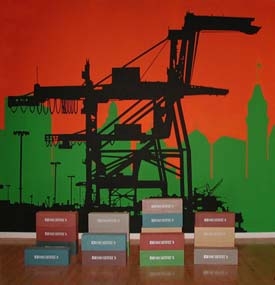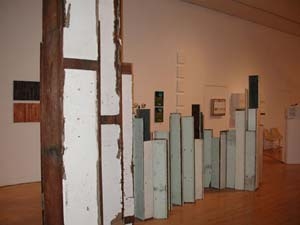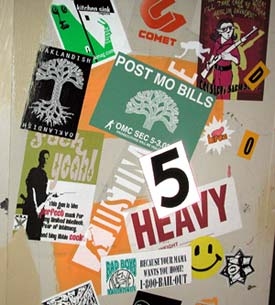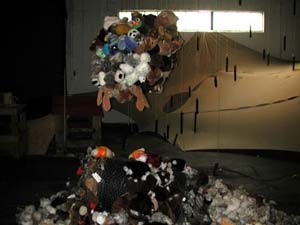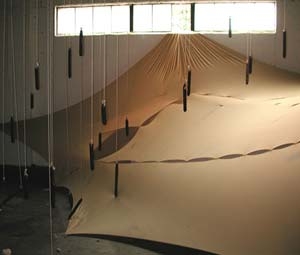Feature: Essays
The Regionalists
The Art of the Bay Area Style
The contemporary art of the Bay Area has a complex and often disputed relevance in the international art world. Tangled with issues of regionalism, burdened by the reputation of being second to Los Angeles, and deprived of significant coverage outside the region, the art center of the Bay Area has been at odds with its status for quite some time. Beyond outside art critics overtly gratuitous use of recycled material and complete oversight of Oakland in the past 30 years, the art of the Bay Area has received little mention in international art publications. The gaping hole left by this lack of exposure has not only resulted in incomplete art coverage at best, but has left the art and artists of the Bay Area with the stale status of cheap and irrelevant to the disservice of the international art world and Bay Area artists alike.
Historically the issue of regionalism in Bay Area art has received an unfair reputation by critics, artists and the art world alike. While the commercialized art center of New York progressed as the unattainable standard, Bay Area art remained heavily individual and regionalist in lieu of hijacking a bandwagon of imitation in order to compete. Ironically, over the past decade regionalism has noticeably become a larger part of a New York art scene, showing itself in Brooklyn and more currently in Queens. The regionalist debate cites commercial successes (which more than usually denotes an art of conformity in some respect) as the main focus of the anti-regionalist thought. Although the prospects are often times monetarily barren for the majority of regionalist art, the challenge of individuality and regional concerns critically assessed in art offer something more candid than can be seriously considered a west coast curse or an inferior art model.
The manifestation of regionalism in Bay Area contemporary art and curation, though disliked by many critics, continues to offer an individualized voice for the disenfranchised artists and art spaces in the Bay Area. Today, in many ways, regionalism in Bay Area art has taken on a status of the contemporary art in droves, delivering fresh stock from barrels of repetition and exhaustion in contemporary art vying for international appeal. This past fall the Richmond Art Center exhibited six East Bay alternative art spaces, (Cricket Engine, Liminal, 21 Grand, Ego Park, Mama Buzz and Epic Arts), in Curate This, formally introducing a tide of art presenting heavy regionalist overtones including a massive wall installation depicting the Port of Oakland by Justin Artifice as well as Eric Groff’s installation recreating a back alley in Oakland off 23rd Street complete with countless Oakland references in graffiti and stickers alike. Alongside the lengthy love-hate affair with regionalism in Bay Area art, it is becoming apparent that the once unsavory regionalism has become a signal of originality in a quickly imitative and overly image processed world.
This homecoming walks a divided line: because regionalism is seen as a weakness, it can be a vulnerable quality easily manipulated into a single source venture for profit, packaged for ease of association and identification. As Leah Modigliani points out in her Stretcher essay Marketing the Mission: Commodifying San Francisco’s Art, The “Mission School” and the Problem of Regionalism the saturation of the “fringe of society” artist and value, as exhibited in Beautiful Losers hosted at Yerba Buena Center for the Arts is not only a great leap of imaginative imports, but a point of exploitation that lacks accuracy in regards to the highly successful career artists included in the exhibition. This example of a formulated image of Bay Area regionalism becomes evident of what occurs when grouping a region in desperation for a single style of representation. As much as it can be a dangerous source of possible dilution and determined cliches when used for over saturated marketing purposes and gross overgeneralizations, regionalism in Bay Area art is not dead. Instead, it has since arrived as a distinct marker of individuality and diverse specialty.
The lack of attention and interest in Bay Area art is mostly due to antiquated attitudes of measure, assisting in inaccurate stereotyping, and quite possibly the largest conflict: a lack of information distribution anywhere outside the region. The larger issue of distribution, by way of writing, cannot be ignored in the conflict of Bay Area art and its dismissal. Art openings are plentiful on a weekly basis in San Francisco, Oakland and Berkeley. These exhibitions, attended by many, are left primarily to memory at the close of the event. The few art writers in the Bay Area are overwhelmed with content that is not manageable for a handful of advantageous writers to cover, while regional coverage is left to feature writers in SF Weekly or the East Bay Express that while entertaining, only provide a briefer on the generalities of the event for the public.
An ideal model for gaining greater attention for the art of the Bay Area would consist of reaching out to the international art world, joining ventures of curatorial proposals, bringing the art and artists of the Bay Area to other cities as well as building alliances with various art spaces and artists outside the Bay Area that exist within the same status as we do. To capture attention and interest for the art and artists originating in the Bay Area, the best method is one of inclusion, not the marketing of a solo package that is inaccurate and mostly built from old stereotypes and convenience.
West Oakland poses an ingenious example of strategy: maintaining regionalism while extending invitation to other lesser known art centers nationwide to participate in exhibitions. In the past few years Oakland has risen to the challenge of forgoing typecasting for actively seeking collaborations with as many bay outsiders as bay insiders. The youthful energy of the few West Oakland warehouse art spaces has awakened an innovative and united spirit within the art scene of Oakland that is indefinitely coupled with regionalism.
The growing art center of Oakland is a sign of moving on from the old debate and onto the action of dialog with other art centers in the same position as the Bay Area, in essence creating alliances that provide a wide distribution of ideas, art, venues, cities and culture beyond the exclusive mainstream circuit. This concept works because it skirts the traditional titles and positions, such as the Bay Area being problematic due to regionalist tendencies or a lack of significance in the international art world, and utilizes a DIY mentality. It has been wildly successful, actively engaging the Bay Area arts community, drawing crowds of artists and participants with ambitious curatorial proposals and a culture of art, music and community.
West Oakland galleries such as LoBot Gallery and Liminal are starting points of a new chapter in Bay Area art. By asserting the relevance of the Bay Area as a place to show your art, a place to keep in contact with and watch for, and a haven for fresh art with diverse and fascinating artists, they are seemingly running a gallery and a promotional campaign at once. LoBot Gallery, founded by artists Adam Hatch (one of the founding members of Liminal) and Caleb Rogers, is a perfect example of an art space that utilizes a DIY ethic while incorporating an attractive mix of local regionalism and open invitation to the larger art community outside the Bay Area. In the spirit of reaching out, LoBot’s openings have been supplemented with musical acts from D.C., Minneapolis, Brooklyn, Oakland, SF, and Seattle, as well as visual artists from across the nation. These openings have drawn interest from a flood of art goers, many admitting upwards of five hundred plus. The inclusive action of LoBot Gallery, as well as other Bay Area art spaces, to intermingle artists and art centers nationwide in their program is a positive move to assert a Bay Area style without gross compromise to a larger audience.
Oakland has proven to be successful as a model of change. Forgoing compromise based on historical position, Oakland has drawn reference to Brooklyn as the second city: the city to look towards for the newest art and the boldest artists that come without pretense or reservation. Oakland has become littered with galleries: ABCo, LoBot Gallery, Liminal, Auto3321, Cricket Engine, Ego Park, 21 Grand, Mama Buzz and Lucky Tackle to name a few. The artists, curators, and arts professionals of a majority of the newer art spaces in Oakland do not dismiss the value of regionalism, in contrast they use it to their advantage as a reference point constantly drawing parallels and association to Oakland in their art and curation as if it were a top art center. This method has given Oakland the beginnings of a unique and exciting art center built on a sustainable ideal: an arts community proud of their origins, accessing art, ideas, and connections on their own terms, not as a historically contested art center.
With Bay Area art, as Oakland’s emerging art scene has definitely proved, we do not have something that needs to be “reinvented” as much as we have something that needs to be appreciated. Regionalism is a positive aspect of the Bay Area’s art history because it offers a place within our reality that is distinct and inspirational to our environment, politics, and history. The Manhattanization of Bay Area art would be highly destructive to the diverse nature of Bay Area art and act primarily to turn a profit in lieu of enriching the cultural and critical value of the Bay Area art scene. The need for a single style to encompass Bay Area art would only work towards marketing a mistake that would further isolate the art of the Bay Area from a greater role in the international art world.

